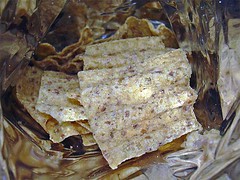From http://en.wikipedia.org/wiki/Monosodium_glutamate
Monosodium glutamate, sodium glutamate, flavour enhancer 621, EU food additive code: E621, HS code: 29224220 (IUPAC name 2-aminopentanedioic acid. Also known as 2-aminoglutaric acid), commonly known as MSG, Ajinomoto, Vetsin, or Accent, is a sodium salt of glutamic acid. MSG is a food additive and it is commonly marketed as a "flavour enhancer".
Although traditional Asian cuisine uses flavour-enhancing ingredients which contain high concentrations of MSG, it was not isolated until 1907. MSG was subsequently patented by the Japanese Ajinomoto Corporation in 1909. In its pure form, it appears as a white crystalline powder; when dissolved in water (or saliva) it rapidly dissociates into sodium cations and glutamate anions (glutamate is the anionic form of glutamic acid, a naturally occurring amino acid).
Health Concerns
In 1959, the FDA classified MSG as a "generally recognized as safe", or GRAS, substance. This action stemmed from the 1958 Food Additives Amendment to the Federal Food, Drug, and Cosmetic Act, which required premarket approval for new food additives and led the FDA to promulgate regulations listing substances, such as MSG, which have a history of safe use or are otherwise GRAS. Since 1970, FDA has sponsored extensive reviews on the safety of MSG, other glutamates and hydrolyzed proteins, as part of an ongoing review of safety data on GRAS substances used in processed foods. One such review was by the Federation of American Societies for Experimental Biology (FASEB) Select Committee on GRAS Substances. In 1980, the committee concluded that MSG was safe at current levels of use but recommended additional evaluation to determine MSG's safety at significantly higher levels of consumption.
And from http://en.wikipedia.org/wiki/High_fructose_corn_syrup
The process by which HFCS is produced was first developed by Richard O. Marshall and Earl R. Kooi in 1957[2] and refined by Japanese researchers in the 1970s. HFCS was rapidly introduced in many processed foods and soft drinks in the US over the period of about 1975–1985.
Health effects
There are indications that "soda and sweetened drinks are the main source of calories in [the] American diet."[18] Overconsumption of sugars has been linked to adverse health effects, and most of these effects are similar for HFCS and sucrose. There is a striking correlation between the rise of obesity in the U.S. and the use of HFCS for sweetening beverages and foods. The controversy largely comes down to whether this is coincidence or a causal relationship. Some critics of HFCS do not claim that it is any worse than similar quantities of sucrose would be, but rather focus on its prominent role in the overconsumption of sugar; for example, encouraging overconsumption through its low cost.
So, my layman’s sloppy conclusion is that if HFCS was introduced in the United States in 1957 and MSG was introduced in 1959, and the obesity of the American public started increasing dramatically after 1960, (according again, to Wikipedia):
http://en.wikipedia.org/wiki/Obesity
Environmental factors
While it may often appear obvious why a certain individual gets fat, it is far more difficult to understand why the average weight of certain societies have recently been growing. While genetic causes are central to understanding obesity, they cannot fully explain why one culture grows fatter than another.
This is most notable in the United States. In the years from just after the Second World War until 1960 the average person's weight increased, but few were obese. In the two and a half decades since 1980 the growth in the rate of obesity has accelerated markedly and is increasingly becoming a public health concern.
I for one, am planning to cut out these nasty additives from my food consumption wherever possible!! Maybe I'll lose those two pounds I gained over the weekend. Was it the Seagrams Gingerale? or the Fritos?





HFCS has invaded our food supply.
ReplyDeleteCourtesy of the Corn Refiners Assoc., www.corn.org/NSFC2006.pdf
lists all the foods and products
that contain HFCS. A few surprises:
soups, bagels, cough syrups. There are lots of lists with foods you shouldn't buy, which isn't much help when you're shopping. StopHFCS.com lists HFCS-free foods. I find it quite interesting that in Europe Coke is still served
in 6 oz glass bottles (and is quite
refreshing and satisfying) and
in the US coke is only sweetened with HFCS and we guzzle liters.
Hawkishly read labels. Take care.
For the new year, let's try to avoid HFCS! Who's with me?
ReplyDeleteHA! Good freaking luck! Everything has HFCS in it! And that's not even including the fast food.
ReplyDeleteWhen you die and the mortician guts you, you will bleed Karo Syrup.
well, on the bright side, you can stock up on coca cola during passover, as coke for passover is made with sugar since ashkenazic jews will not eat corn or any of its products during that time.
ReplyDeletesee, i'm already helping you toward better health.
you're welcome.
Yeah, we try to not eat those things either, but it is so freakin' hard to avoid. MSG is often unlabeled (lumped into the "other additives" category) and HFCS is EVERYWHERE.
ReplyDeleteHi,
ReplyDeleteTo avoid HFCS-- European import stores are a good bet. Europe doesn't allow genetically modified foods (GMO) which safely eliminates HFCS. I've also read where Mexican stores have HFCS-free food, but I can't personally verify. According to the terms of the NAFTA agreement, on Jan 2008 Mexico will be finally allowed to import sugar to the US; however, that is in exchange for the US starting to to ship HFCS with out the Mexican import tariff. Poor Mexico.